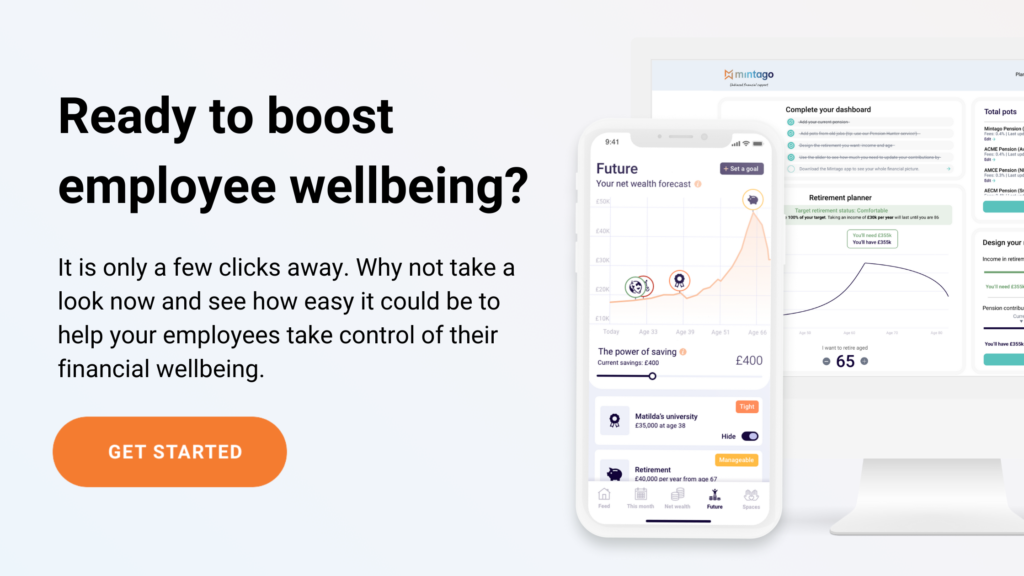When talking about financial wellbeing, one size does not fit all but here we map out what a typical financial path may look like for your employees. There are two uses for money:
- Security: To pay for things that let your employees and their loved ones survive.
- Freedom of choice: To pay for things that let your employees and their loved ones live the life they want
One can’t have freedom without security. Financial wellbeing is the endpoint of a journey that takes an individual through securing their today and tomorrow and then unlocking the freedom to choose the life they want to live.
The journey to financial wellbeing
Whilst everyone is different, and the journey will not be the same for each person, there are broadly seven key steps on the journey to financial wellbeing
Step 1: Budget, reduce expenses and set realistic goals
Step 2: Maximise the amount of free money your employees can get (from employer or state support)
Step 3: Pay off expensive short term debt
Step 4: Build an emergency fund
Step 5: Save for short term goals (goals in less than 5 years)
Step 6: Save for long term goals (goals in more than 5 years)
Step 7: When all of these are satisfied, kick back and let your team enjoy financial freedom
Let’s dig into the steps in a bit more details.
Step 1: Budget, reduce expenses and set realistic goals
To kick-start your employees financial wellbeing journey, they first need to create a solid budget. Begin by helping them list fixed expenses such as rent or mortgage, council tax, food, car payments, insurance and utility bills. Then they must add any discretionary spending such as eating out, clothing and entertainment. Remind them to also include any “one offs” and annual payments which can be converted into a monthly bill for budgeting purposes.
Once they’ve created their budget, have them compare their costs with their monthly take home pay. Then have them track their spending to see where they can begin making changes and cutting costs. While it tends to be easier to reduce discretionary expenses, a great way to cut costs is to reevaluate household bills as many people overpay on their gas, electricity, broadband and phone bills.
Make sure they are setting achievable, specific and measurable goals or they won’t be able to sustain and keep track of their new saving habits. Don’t forget to remind them to reward themselves when they hit a goal!
Step 2: Maximise the amount of free money they can get (from employer or state support)
The first part of step 2 is checking out whether they are maximising the amount of state support they can get. A great site is entitledto which has a calculator designed to tell your employees whether they are eligible for any state benefits that put more cash in their pocket.
Secondly, pension auto-enrollment means that if they put 3% of their salary into their pension, as the employer, you have to put in another 5% on top. Although 3% of their salary may sound a lot, by doing so they can effectively turn £1 of salary into £3.60, well worth it if you ask us!
Some great employers take this further and match pension contributions. You should check with your employer if this is the case and then see whether you can afford to take advantage of this if so.
Step 3: Pay off expensive short term debt
If your employees are reliant on credit to make ends meet, they can seek debt counselling from a reputable charity such as Step Change.
When it comes to debt repayments, focusing on high interest debt can be the most efficient strategy over time if they’re able to stick to it. The second option would be to focus on repaying small debts which would then snowball into larger successes. While less efficient, this option can have psychological benefits. In both cases they should make the minimum payments on all of their debts and then choose which method to add extra money to.

Step 4: Build an emergency fund
Step 4 lies right in the middle of security and freedom of choice. For an emergency fund employees should aim to save 3-12 months of necessary living expenses that are easy to access. If this sounds intimidating, remind them that any amount will help pay for unexpected expenses. Research from the London University UCL found that having £1,000 in the bank can make individuals financially happier.
Step 5: Save for short term goals (goals in less than 5 years)
As your staff edges closer towards financial freedom, they can focus on their life goals. For short term goals that are within 5 years, they can keep their savings in cash and find the highest-paying savings accounts to store them.
Are they looking to buy their first home? They can consider opening a Lifetime ISA (LISA). This government product aimed at those aged between 18 and 39, allows to deposit up to £4000 per tax year and get a 25% government bonus on any contributions made. That means for every £4 saved, they get £1 for free which over time can really add up.
Step 6: Save for long term goals (goals in more than 5 years)
When employees start saving for long term goals, they might want to consider investing options such as a Stocks & Shares ISA. Investing over the long term (5 or more years) can offer higher returns, although the value of investments can go up and down. Should they want to buy a house in 5 or more years time a S&S LISA is also available.
Saving for retirement is also important, and they can make additional contributions into the workplace pension or open a SIPP and invest in low-cost global index trackers. A general rule of thumb for pension is to take the age they start their pension and halve it. Then put this % of their pre-tax salary into their pension each year until they retire. So if they began saving at 24, they should aim to contribute 12% of their salary. While this figure may seem high, it also includes employer’s contributions.
Step 7: When all these are satisfied kick back and let your team enjoy financial freedom
Note: The Content is for informational purposes only, you should not construe any such information or other material as investment, financial, or other advice.
